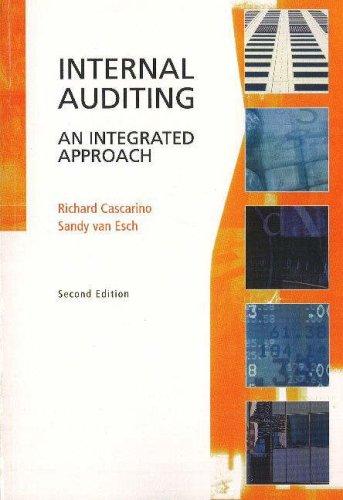Question
Applied Software has a $1,000 par value bond outstanding that pays 13 percent interest with annual payments. The current yield to maturity on such bonds
Applied Software has a $1,000 par value bond outstanding that pays 13 percent interest with annual payments. The current yield to maturity on such bonds in the market is 11 percent. Use Appendix B and Appendix D.
Compute the price of the bonds for these maturity dates: (Round "PV Factor" to 3 decimal places. Do not round intermediate calculations. Round the final answers to 2 decimal places.)
| Price of the bond | |
| a. 25 years | $ |
| b. 19 years | $ |
| c. 5 years | $ |
Ron Rhodes calls his broker to inquire about purchasing a bond of Golden Years Recreation Corporation. His broker quotes a price of $1,160. Ron is concerned that the bond might be overpriced based on the facts involved. The $1,000 par value bond pays 12 percent annual interest payable semiannually, and has 20 years remaining until maturity. The current yield to maturity on similar bonds is 8 percent.
a. Compute the new price of the bond. Use Appendix B and Appendix D. (Round "PV Factor" to 3 decimal places. Do not round intermediate calculations. Round the final answer to 2 decimal places.)
New price of the bond $
b. Do you think the bond is overpriced?
-
No
-
Yes
Martin Shipping Lines issued bonds ten years ago at $1,000 per bond. The bonds had a 30-year life when issued, with semiannual payments at the then annual rate of 9 percent. This return was in line with required returns by bondholders at that point, as described below:
| Real rate of return | 5 | % |
| Inflation premium | 4 | |
| Risk premium | 2 | |
| Total return | 11 | % |
Assume that today the inflation premium is only 1 percent and is appropriately reflected in the required return (or yield to maturity) of the bonds.
Compute the new price of the bond. Use Appendix B and Appendix D. (Round "PV Factor" to 3 decimal places. Do not round intermediate calculations. Round the final answer to 2 decimal places.)
New price of the bond $
Lance Whittingham IV specializes in buying deep discount bonds. These represent bonds that are trading at well below par value. He has his eye on a bond issued by the Leisure Time Corporation. The $1,000 par value bond with semiannual payments has 8 percent annual interest and has 15 years remaining to maturity. The current yield to maturity on similar bonds is 14 percent. (Round "PV Factor" to 3 decimal places. Do not round intermediate calculations. Round the final answers to 2 decimal places.)
a. What is the current price of the bonds? Use Appendix B and Appendix D.
Current price $
b. By what percent will the price of the bonds increase between now and maturity?
Price increases by %
c. What is the annual compound rate of growth in the value of the bonds? (Use Appendix A)
Annual compound rate %
Airdrie Lanes preferred shares pay an annual dividend of $1.20, payable on a quarterly basis. Current yields of similar risk preferred shares are 3 percent.
What is the price of each preferred share?
Price of preferred share $
Stagnant Iron and Steel Co. currently pays a $10.10 annual cash dividend (D0). It plans to maintain the dividend at this level for the foreseeable future, as no future growth is anticipated.
If the required rate of return by common shareholders (Ke) is 20 percent, what is the price of each common share? (Round the final answer to 2 decimal places.)
Price of common share $
The Fleming Corporation paid a dividend of $0.75 last year. Over the next 12 months, the dividend is expected to grow at 8 percent, which is the constant growth rate for the firm. The new dividend after 12 months will represent D1. The required rate of return is 15 percent.
Compute the price of a common share. (Round the final answer to 2 decimal places.)
Common share price $
A firm pays a $1.80 dividend at the end of year one. It has a share price of $50 (P0) and a constant growth rate (g) of 9 percent.
a. Compute the required (expected) rate of return (Ke). (Do not round intermediate calculations. Round the final answer to 2 decimal places.)
Required rate of return %
Also indicate whether each of the following changes would make the required rate of return (Ke) go up or down. (In each question below, assume only one variable changes at a time. No actual numbers are necessary.)
b. If the dividend payment increases;
-
Ke will go up.
-
Ke will go down.
-
Ke remains constant.
c. If the expected growth rate increases;
-
Ke will go up.
-
Ke will go down.
-
Ke remains constant.
d. If the stock price increases;
-
Ke will go up.
-
Ke will go down.
-
Ke remains constant.
Step by Step Solution
There are 3 Steps involved in it
Step: 1

Get Instant Access to Expert-Tailored Solutions
See step-by-step solutions with expert insights and AI powered tools for academic success
Step: 2

Step: 3

Ace Your Homework with AI
Get the answers you need in no time with our AI-driven, step-by-step assistance
Get Started


